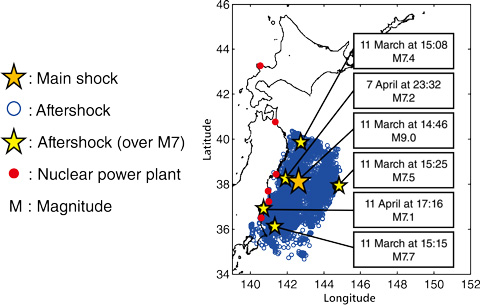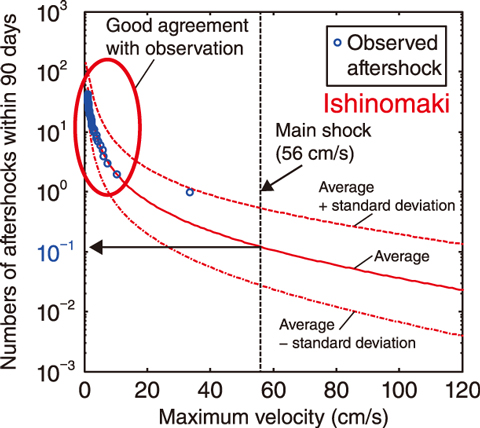
Fig.2-11 Aftershock distribution caused by the 2011 Tohoku earthquake

Fig.2-12 Aftershock hazard evaluation of the 2011 Tohoku earthquake (at Ishinomaki, within 90 days of the main shock)

Fig.2-13 Example aftershock hazard map
During conventional seismic probabilistic risk assessments (seismic PRAs) of nuclear facilities, only the impact of main shocks are considered; evaluation methods considering aftershocks have not yet been established. In the aftermath of the 2011 Tohoku earthquake, which logged the largest recorded magnitude (M) in Japan, M9, several large-scale aftershocks of M7 and above were reported, many of which caused significant damage (see Fig.2-11). This presented an opportunity to reconsider the effects of aftershocks during seismic PRAs. This research therefore was focused on the development of a seismic hazard assessment method that evaluates the possibility of a nuclear power plant being affected by large earthquake motions; further, aftershock hazard evaluation methods that consider the impacts of large aftershocks were investigated.
One of the issues associated with seismic hazard evaluation methods considering large aftershocks is the difficulty in predicting the timing, scale, and probability of aftershocks. To address this, aftershock records of large main shocks exceeding M7, including the M9-class Tohoku earthquake, were analyzed and used to develop a semi-empirical aftershock model. Based on the analysis of the aftershock records, the scope of application of the conventional aftershock occurrence model was expanded to aftershocks of large main shocks of the M9 class. This includes the relationship between the main shock and aftershock scales and the relationship between the aftershock scale and numbers of aftershocks. Aftershock hazard evaluation methods, which could be used to calculate the relationship between the intensity (maximum velocity) and numbers of aftershocks, were then proposed by combining the aftershock occurrence model and distance attenuation formula of the conventional seismic hazard evaluation method. As an example, the aftershock hazard following the 2011 Tohoku earthquake was evaluated and compared with observed data, as shown in Fig.2-12.
To apply this evaluation method to the seismic PRA of a nuclear facility, a typical aftershock scenario can be considered for a nuclear power plant, and aftershock hazard evaluation can be performed in advance. Further, an aftershock hazard map based on the predicted probability of an aftershock exceeding the seismic intensity of the main shock was proposed. This map, an example of which is shown in Fig.2-13, could be used in the development of wide-area evacuation plans.
Domestic nuclear facilities in Japan are required to implement disaster prevention and mitigation measures in preparation for a predicted Nankai Trough earthquake, which is expected to cause large aftershocks over a wide area. Therefore, it is essential to establish a seismic PRA method that appropriately considers the effects of large aftershocks.
Accordingly, aftershock hazard evaluation methods are under development and efforts to improve the more realistic seismic PRA method, which accounts for the effects of the main shock and aftershocks, are ongoing.
(Byunghyun Choi)